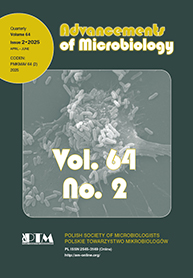Czynniki wirulencji grzybów z rodzaju Candida istotne w patogenezie zakażeń występujących u pacjentów żywionych pozajelitowo
1. Wstęp. 2. Czynniki ryzyka wystąpienia zakażenia o etiologii grzybiczej. 3. Czynniki wirulencji grzybów drożdżopodobnych z rodzaju Candida. 4. Zjawisko wzrostu w postaci biofilmu. 5. Sekrecja enzymów hydrolitycznych. 6. Zjawisko dimorfizmu. 7. Podsumowanie
Abstract: Fungal infections constitute a vital clinical issue concerning various groups of patients, among them patients with total parenteral nutrition. The most common etiological infection factors, affecting the aforementioned group of patients, are among others yeastlike fungi. In clinical specimens, the predominant genus of yeastlike fungi, as isolated from the patients with total parenteral nutrition, is Candida spp. The species of yeastlike fungi of the Candida genus generate various pathogenic factors enabling invasion process and the progression of the subsequent infection stages. The most crucial of them are:
• ability to adhere and ability to form biofilms. This feature, with the mediation of adhesion proteins, enables the fungi to grow on the biomaterial surfaces, to invade the host’s tissue, and conditions survival and existence in the environment;
• dimorphism. Creation of two antigenically different forms – yeast and hyphae – conditions specific escape from the immunological system of the macroorganism;
• high enzymatic activity. Hydrolytic, proteolytic and lipolytic activity, featuring primarily the adaptative function, is the indicator of the metabolic stimulation required for the infection process,
Due to the insignificant pathogenic potential of the Candida genus fungi, associated with the fact of their natural existence on skin and mucous membrane, the research is currently often directed at detection of the factors responsible for the colonisation and development of the fungal infections. These research attempts are aimed at differentiating between both processes.
1. Introduction. 2. Risk factors of fungal infections. 3. Virulence factors of the Candida genus. 4. The phenomenon of biofilm formation. 5. Hydrolytic enzymes secretion. 6. Dimorphism. 7. Conclusions

